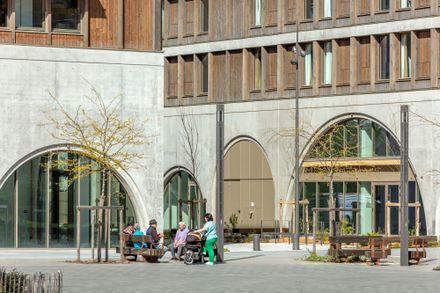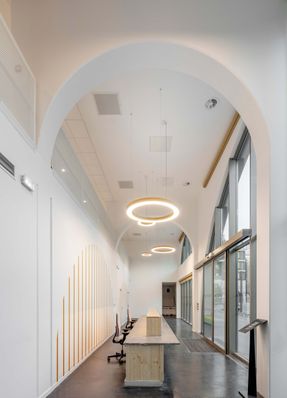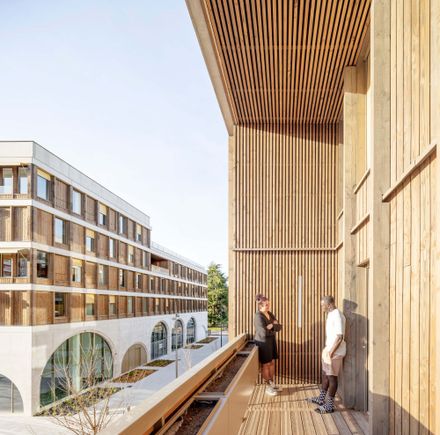ARCHITECTS
Cobe Architecture & Paysage
CLIENT
Pau Béarn Habitat
ACOUSTICAL ENGINEERING
Gamba
PARTNER ARCHITECT
Week
YEAR
2023
LOCATION
Pau, France
CATEGORY
Mixed Use Architecture
Spread over two buildings, the project has a mixed materiality made of wood, concrete and glass, and is part of a global sustainable development approach combining bioclimatic design, bio-based materials, and energy performance.
The Saragosse district in which the project is built was designed in the 1950s and 1960s. Its urban renewal project has identified it as a territory in great social fragility but with a very favorable urban position, close to the city center of Pau.
Saragosse is now the most important social housing district of the urban area with about 14,000 inhabitants, and is subject to intrinsic fragilities:
its urban planning is characteristic of the big housing estates era, the low rents it offers make it a solution for people in precarious situations, and the supply of local trade and equipment is very fragile.
Faced with this observation, the State, with the ANRU (National Agency for Urban Renewal) and the city of Pau, has decided to invest heavily in this district alongside the social landlord Pau Béarn Habitat.
Renovations, demolitions and landscaping projects aimed at requalifying collective spaces at the foot of buildings are scheduled until 2027.
The city of Pau is investing heavily in the development of bike paths, public transport and in the creation of a district heating network that allows the sector to be labeled «EcoDistrict».
The construction of the Laherrère center is one of the priority axes of the urban renewal program of the Saragosse district. It is based on the general idea of creating two buildings:
one to respond to the problem of housing for students and young workers and another for companies or associations mainly focusing on integration through employment, with services and shops on the ground floor.
In the heart of the district was located an old hospice unoccupied and in very poor condition.
The city proceeded with its demolition and wanted to build a qualitative real estate complex on the land left free, energizing, and attractive both for the inhabitants and for the outsiders who will come to work and meet there.
It is in this context that the design competition for the creation of the Laherrère center was launched in 2018, won by CoBe (main architect) and WEEK (co-contractor).
The primary intention of the project was to constitute a real living space, on the model of a village square, like the market that the site has hosted since the beginning of the work.
The two L-shaped buildings, firmly anchored on Laherrère square, both adopt the same volumetry and the same materiality composed of wood and concrete.
On the two levels of the ground floor their structure rises in elegant proportions with low carbon raw concrete arches poured on site.
Some arches sometimes rise on two levels and are inspired by the local historical architectural language, while structuring the new square and promoting the reactivation of neighborhood life.
On the five upper floors that make up the two buildings, the expression becomes lighter by sporting wood-frame facades with wood fiber insulation, wood joinery and warm-colored blinds, and reveals the rich and varied programming of the project.
The frame of the façade is made of pectinated fir from forests of the Pyrénées Atlantiques and Hautes-Pyrénées, while its coating is made of pre-grayed Douglas fir from the Auvergne Rhône Alpes region.
The joinery of the building is produced from Scots pines from Corrèze. Thus, all the wood species constituting the project come from French forests located less than 450km from the site.
Being at the same time a place of life, work, professional training and economic development, the Laherrère pole contributes to improving the living environment of the inhabitants of the Saragosse district and to meeting a maximum of needs.
The post and beam construction system put in place, in addition to its frugal dimension, makes it possible to accommodate a wide range of programs within the same project, and makes it possible to anticipate a possible evolution of this programming during the life of the building.
Thus the real estate complex includes: 1. A housing hub with 116 student housing units managed by the CROUS (social organization for students) and 60 housing units for young workers managed by the Habitat Jeunes Pau Pyrénées association with shared common spaces, in connection with the professional training and integration activities present in the project.
2. An entrepreneurial hub with office and coworking floors used in particular by associations, professional training structures and support for business creation such as the Cuisine Mode(s) d’Emploi school and its training restaurant founded by Michelin-starred chef Thierry Marx, the Simplon school and the 2nd chance school, as well as five craft premises.
3. Local services and shops to meet the needs and expectations of residents such as a police station, services related to employment, a concierge, two breweries, and sales spaces related to craft premises.
A “conviviality room” (multipurpose room) of 234 m2 also allows the organization of various events and is accessible by reservation to all the inhabitants of the project and the district.






































